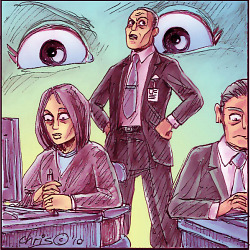
The boss from hell!
Whether they’re in the tyrannical hall of fame — George Steinbrenner — or the hysterical — Michael Scott on “The Office” — bad bosses have always been a bane. These days, it seems office tyrants are having a free-for-all, and it’s harder than ever to do something about it.
Experts say you can blame the economy.
Under-pressure bosses act crankier, and corporate downsizing increasingly leads to promotions of people who make bad managers, said Vicki Lynn, vice president of research and consulting at career management site Vault.com.
Unhappy employees, meanwhile, are afraid to leave their jobs.
“Sometimes, if you even complain, you risk getting fired for complaining,” said Lewis Maltby, author of “Can They Do That? Retaking Our Fundamental Rights in the Workplace.”
Case studies on office tyranny
You might think you have a bad boss, but imagine one who walks around
the office doing panty-hose inspections.
This hard-to-believe scenario is real, according to Denise, the founder of venting site reallybadboss.com.
Sometimes, the bad boss is not just the head of the office — he’s the head of state.
In the new book, “The End of The Party,” journalist Andrew Rawnsley accuses Prime Minister Gordon Brown of scaring his colleagues and subordinates through
verbal abuse and bullying. The country’s National Bullying Helpline even admitted to receiving calls from Brown’s office.
How to beat a bully
These may be clear-cut cases, but how do you know if you’re boss is crossing the line? You can be a tough, demanding boss and never raise your voice or make derogatory comments, Maltby said.
Linnda Durre, author of “Surviving the Toxic Workplace,” described a bad boss as someone who is “mean, never compliments you, is harsh, has no flexibility and overworks people.”
But a bad boss often makes people anxious, spiteful and vengeful and slows down the workflow, said Durre.
Badgered employees have several options.
“If you have a boss you know is a good guy, but is letting stress get to him, speak to him privately and nicely. If they’re not and they’re just being difficult, you may not want to say anything — you can get fired,” Maltby said.
If confronting your boss is not an option, turn to human resources, but do that carefully.
”Unfortunately, the state of HR has gotten worse in the last 20 years,” Maltby said. “HR used to be an independent department with VPs that were at the same level as the boss. Now they often work for the legal department which is bad, or for the CFO, which is worse.”
If all else fails, start thinking about leaving.
But while you look for a new job, take advantage of any opportunities your current job offers.
“I realized it was not going to work, but I took everything positive I could get from the environment, and used it to empower myself,” Denise said.
Quick tips for handling a bad boss:
1. Leave it at work. Try not to take negative feelings home
with you.
2. Don’t take it personally. The problem is with your
boss’s management skills or his personality, not you.
3. Don’t talk to co-workers about it. To avoid conflicts, experts recommend confiding in someone neutral who’s off-site.
4. Speak to your boss. As long your boss is not entirely
irrational, it may be worth airing concerns.
5. Consult HR. If you’ve witnessed your HR department handle things well, turn to them.
6. If all else fails, start looking for a new job. You don’t want to wait until things become unbearable or you risk being fired.
Vicki Lynn’s 7 types of bad bosses:
1. Empty suit — Someone who looks good and is very verbal,
but lacks skills to manage properly and give direction. The verdict: These bosses are pretty easy to handle, just document concerns and confront them. [Michael Scott, “The Office”]
2. Command and control — An old-fashioned, militaristic
manager. The verdict: As long as you express your feelings well, these bosses can be bearable. [President Nixon]
3. Benign neglect — A boss who is so busy doing his or her own thing that they don’t manage the team. The verdict: These bosses can be good for self-starters. [David Paterson]
4. Micromanager— A manager who gets involved in every tiny aspect of the company and can’t delegate. The verdict: Script what you want to say, and explain that you want both of you to succeed, but that things need to change. [George Steinbrenner]
5. Blunt object — A boss who is tough, emotionless and has no work-life balance. The verdict: These people tend to admire those who are more creative, open and flexible. Offer to take on tasks they don’t like. [Anna Wintour]
6. Divide and conquer — A boss who plays favorites and plays employees off one another. The verdict: This is really bad. Record the instances, try and face the boss or contact HR. As a last resort, start looking for something new. [Rudy Giuliani]
7. The cancer – A screamer who’s nasty, irrational, unreasonable and hard to understand. The verdict: Go to HR, but ensure everything you say is held in confidence. These are the people that can ruin your career. You might want to leave. [Prime Minister Gordon Brown]

